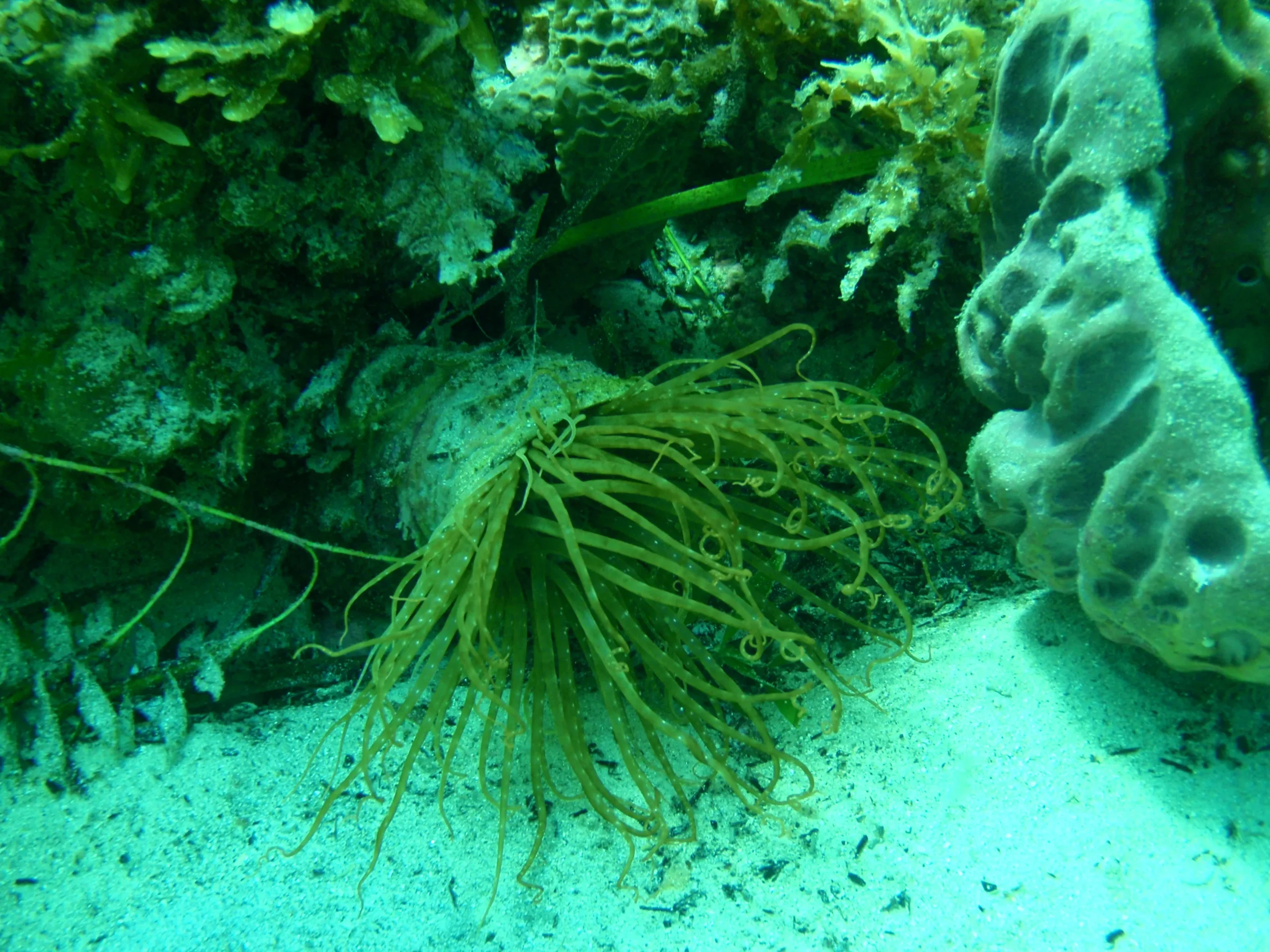I have now seen a large (Cerianthid?) tube anemone at Second Valley three times in 8 years.
As I explained in my Facebook post at https://scontent.fadl4-1.fna.fbcdn.net/v/t39.30808-6/327280926_775335964105281_4473479003342201618_n.jpg?_nc_cat=100&ccb=1-7&_nc_sid=730e14&_nc_ohc=l0XrzlhZeNwAX-gaXpK&_nc_ht=scontent.fadl4-1.fna&oh=00_AfA9XxDPaM0uUykkaJDKvx_IWS-vKzXif5qIC94bEwr3wQ&oe=63D91959 , “I caught up with 3 ‘old friends’ at Second Valley today (27/1/23).”
I wasn’t referring to my dive buddies, but three creatures that I had (first) seen 8 years ago, back in January 2015.
The 3 creatures in question were the large (Cerianthid?) tube anemone and two sponges, as shown here: –
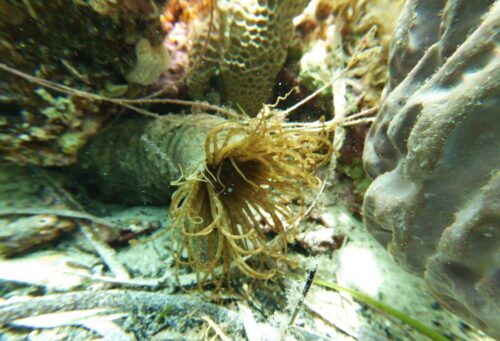
Close-up of tube anemone in 2023
They are the same three creatures in my photos at https://mlssa.org.au/2015/05/05/tube-anemone-sighting-at-second-valley/.
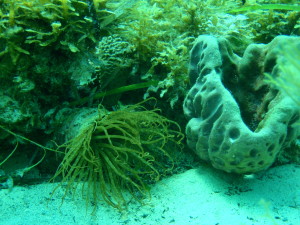
The tube anemone in 2015
They all seem to have grown a little in the past 8 years. The anemone is thought to be a species of Cerianthid tube anemone.
When I searched for other sightings on iNaturalist, I discovered that I had also seen and photographed* the same anemone in January 2019 – see https://inaturalist.ala.org.au/observations/19943101.
* It was actually video footage that I took of the tube anemone in 2019. It can be seen at https://photos.onedrive.com/photo/F49CDA2CA5C2599B!10856?view=all . Here are a couple of stills taken from my video footage: –
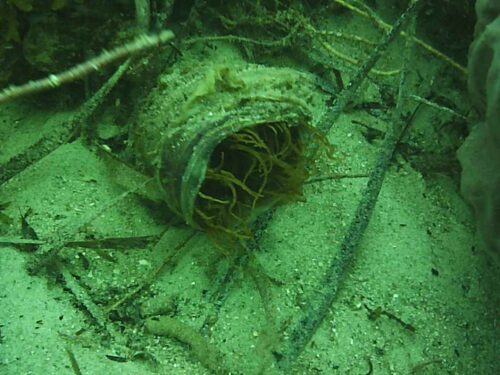
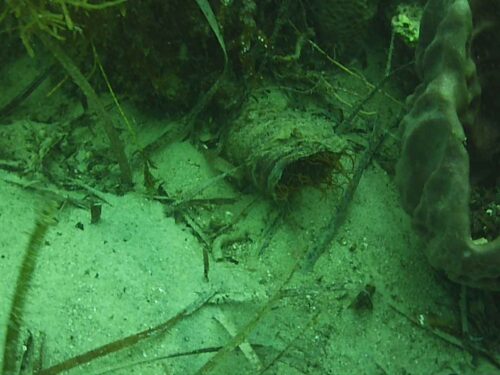
Two frames from video footage taken in 2019
My January 2019 sighting was reported at Second Cerianthid Sighting at Second Valley
So I have seen the same anemone three times over eight years (2015, 2019 & 2023). Each sighting has been in January (6/1, 25/1 & 27/1).
My first (2015) sighting of the anemone was posted to the Atlas of Living Australia site (see two images above). Visit the Atlas of Living Australia for the classification of Cerianthids.
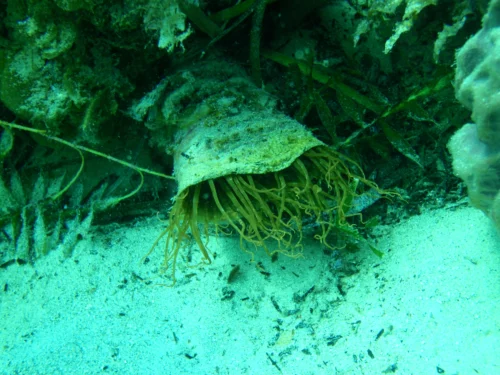
Tube anemone with tentacles retracted (2015)
As stated in my article at https://mlssa.org.au/2015/05/05/tube-anemone-sighting-at-second-valley/ (according to “A field guide to the marine invertebrates of South Australia” by Karen Gowlett-Holmes”):
“Order Ceriantharia – A group of large, solitary, anemones living in leathery tubes buried in sediments. Column is very worm-like with no pedal disc. They have numerous tentacles in two rings – an outer ring of long tentacles and an inner ring of much shorter tentacles which are often a different colour to the outer ones.”
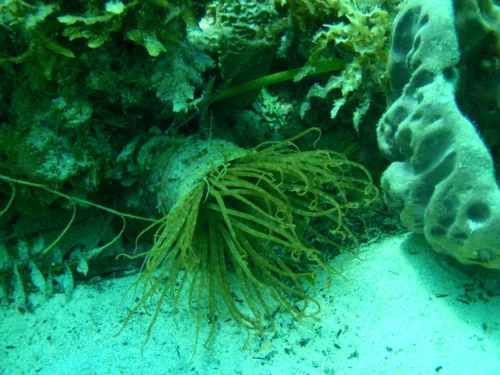
Close-up of tube anemone in 2015
The guide included two photos of a single unidentified species, along with the details: –
“Family Cerianthidae – To 50mm tube diameter. Found in sand, on sheltered to moderately exposed coasts; 2-15m depth. Outer tentacle ring red-brown with regular pale spots; inner tentacle ring pale grey to cream. Probably an undescribed species.”
“The Fringe of the Sea” by Isobel Bennett features a black & white photo of “Cerianthus, a burrowing, tube-building anemone from Sydney Harbour” (Plate 3) and more black & white photos on Plate 41 (a, b & c).
Page 136 of “Australian Marine Life” by Graham J Edgar has photos of three species – Pachycerianthus delwynae, P.longistriatis and an undescribed Pachycerianthus species.
Some Cerianthid photos can be found on Flickr, but other species are included in the group of photos there. The range and number of images there is nothing short of amazing.
I found a 1995 paper titled “Pachycerianthus (Anthozoa: Ceriantharia: Cerianthidae ), Two Newly Described Species from Port Jackson, Australia” by Scott Carter. The two species in question are Pachycerianthus delwynae and P.longistriatis.

The tube anemone in 2023
“Marine Invertebrates of Southern Australia – Part I” edited by SA Shepherd & IM Thomas” has some relevant details on pages 160-1. “Australian Sea Life – South of 30°S” by the late Neville Coleman features photos of two undescribed species on pages 41-2. The species featured on page 42 somewhat resembles my sightings at Second Valley.
My 2015 sighting is found at https://biocache.ala.org.au/occurrences/725f374a-2b19-4917-978b-faae850f3f74 (Record: 554853a13dff54ce96abd27f | Occurrence record | Atlas of Living Australia (ala.org.au) )

Close-up of tube anemone in 2019
(Taken from video footage)
My 2019 sighting is also posted to ALA at https://biocache.ala.org.au/occurrences/6976549f-10c9-4c2c-805f-a884b835300c (Record: Observations:19943101 | Occurrence record | Atlas of Living Australia (ala.org.au) )
It is disappointing that there is still no ID on iNaturalist for my 2019 sighting or on ALA for my 2015 & 2019 sightings.
There are also 5 records for preserved specimens from the SA Museum on ALA – see https://biocache.ala.org.au/occurrences/search?q=lsid%3Ahttps%3A%2F%2Fbiodiversity.org.au%2Fafd%2Ftaxa%2F2dacfbc5-165b-4802-8b90-5a75951a2a83&qualityProfile=ALA&fq=state%3A%22South+Australia%22 . There is also no species ID for any of these. Some are only identified to genus level (Cerianthus).
Several of the preserved specimens from the SA Museum were collected by past Society members or our current Patron.

